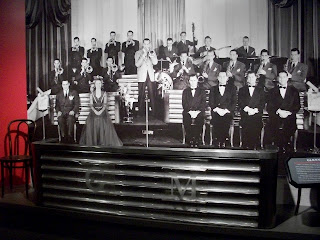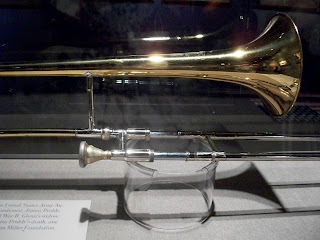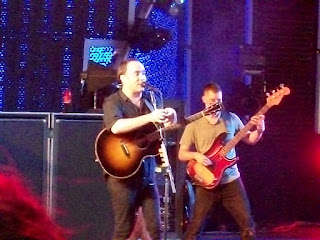Several of my oft-visited websites are getting into the Thanksgiving Day spirit (the Thanksgiving holiday in itself is ultimately a slaughter sacrifice of an innocent bird followed by the consumption of way too many calories followed by sitting around on the couch watching an equally non-sensical sporting match all the while trying to tolerate family members you see perhaps twice a year who insist on repeatedly asking you questions like "well why aren't
you married yet?"). One site offered not one, but TWO videos of animated turkeys doing something called "dubstep," and also included an MGM cartoon from 1940 called
Tom Turkey & his Harmonica Humdingers. These old cartoons always have the most interesting soundtracks.
This cartoon is about a turkey, let's call him Tom. Not only is Tom wearing clothes (looking quite snazzy in a green suit and pork-pie hat) he's walking around a settlement run completely by barnyard birds who all, as will be seen, have great skill with musical instruments. I take some issue with this because birds lack lips with which to make a proper seal on a harmonica (or on a whistle, an instrument that pops up later) to produce a good sound, but no one asked me. Okay, so Tom is strolling around playing his harmonica, which I think is a chromatic harp because the music in the cartoon obviously changes keys. A
chromatic harmonica is much larger than a standard
diatonic harmonica because there are literally more notes. Chromatic harmonicas work the same way as a diatonic (that means organized by a scale, in this case a major scale), but they are larger and have a button on one side to shift a mechanism to close off certain holes. In this way, the player can play in many keys, instead of just one.
Diatonic harmonicas have reeds that are tuned to produce a specific pitch when blown in and drawn out. In other words, when you blow into a hole on a harmonica one pitch is produced, but when you suck the air back in, the reed produces a different note.
Anyway, Tom is playing his chromatic harp (harp is another term for harmonica) causing a bit of a stir to the other birds, and he wanders into a general store. It isn't clear whether he knows the manager of this establishment, or even if harmonica playing is generally permitted in the store, but Tom walks (or rather boogies) right in playing a plucky version of
Turkey in the Straw, which I think is a bit obvious, not to mention stereotypical, but what do I know about the inter-ornithological social and psychological workings of a town full of birds? He manages to somehow offend a lady turkey on his way into the store. It isn't made clear whether he knows the lady turkey or not.
The store is armed with a policebird, who is clearly more interested in shoplifting crackers than protecting the store from unseemly harmonica players. I am tempted to play the "obvious" card again, but I can't tell for sure if the police bird is a parrot. If he is, he is not very colorful or vocal, but that may be why he's working security in a quiet agricultural town.
Tom has a seat by the stove, announces his presence and dives into a spirited rendition of
Darktown Strutters Ball. The intro rouses the bird hanging around the storefront, who pulls out his own harmonica and joins right in. Two birds playing checkers (loitering in a place of business, no doubt) hear the tune and leave their game to add some harmony. Tom shows off his improvisation skills, then the ensemble collectively push the tempo, and throw in some super choreography. The ruckus attracts the attention of an elderly gentlebird making his way past the store. Harmonica music must have restorative properties, because he throws off his cane and ear-horn (the better to hear you with, my dear) and leaps into the store, armed with a whistle. Entering the fray of harmonicas, the old gent is literally whistling
Dixie. The tune takes over the harmonica-ists (is that right?) and they fall in, marching along to
Dixie.
The marching starts to shake apart the building, much like military armies can do if they don't break step while crossing a bridge. The shop-owner only now shows any concern for the musical chaos that is taking place in his store. And who could blame him? His livelihood (and a lot of costly inventory) is about to get the earthquake treatment by a bunch of rowdy chickens! He implores the policebird for some help, but as before, the policebird is too concerned with eating the inventory instead of protecting it. Hopefully, his behaviour is reported to his superiors.
Of course, the musicians completely destroy the store (insert musicians destroying hotel rooms joke), with no hindrance from the police bird (insert lazy, donut-eating cop joke). Out of the wreckage, Tom rises up, calling his fellows back to play. The music used here is from a tragic opera called
Lucia de Lammermoor by Gaetono Donizetti, written in 1835. The title,
Chi Mi Frena in Tal Momento, translates as "what restrains me in such a moment?" Nothing, apparently.
Segueing into an unapologetic
While Strolling Through the Park One Day, Tom moseys away, satisfied with creating such a terrible mess, singing the tune this time (he should stick to the harmonica) when he passes a mannequin in the shop's window. The mannequin is not birdlike, but a lovely female human figure in a charming purple dress. Tom grabs the gal and begins dancing to a harmonica band accompaniment.
The shopkeeper is at his wit's end, trying to get the policebird to do
something about all the unruly behavior, when he finally decides to take matters into his own claws. Storming over to the shop window mannequin-Turkey dance party, the shopkeeper begs Tom to take some responsibility. I really feel for the guy, he's so upset. His shop and inventory is ruined, and in this economic climate, that kind of devastation can be really hard to come back from (unless he has some really good insurance coverage).
Walking by the store, again it seems, is the lady turkey that Tom had managed to offend in some way before he did his bull-in-a-china-shop impersonation. Maybe Lady Turkey is Tom's girlfriend or wife; it's difficult to know for sure because Lady Turkey's character development in this saga is seriously lacking. Anyway, she notices Tom's shadow dancing with the mannequin's shadow behind the shop window screen and is visibly unhappy about what looks like some disrespectful behavior.
The ruckus had alerted the significant females of the other harmonica-ists (really, is that right? It sounds wrong.) and they all storm into the shop, carrying various forms of benign weaponry (umbrella, rolling pin, frying pan) and take back their men. As far as I could tell, the guys were really only guilty of property damage, but the gals may be angry because this will now lead to paperwork, visits from insurance people, and claims adjusters, and most likely the police force (if they stop eating crackers long enough to ask questions and make the necessary citations) and, possible, some jail-bird time.
The moral of the story: no harmonicas unless you have really good business insurance and some better-behaved friends.
P.S.
humdinger is defined as a person, thing, action, or statement of remarkable excellence or effect. These birds were certainly some effectual humdingers.








































